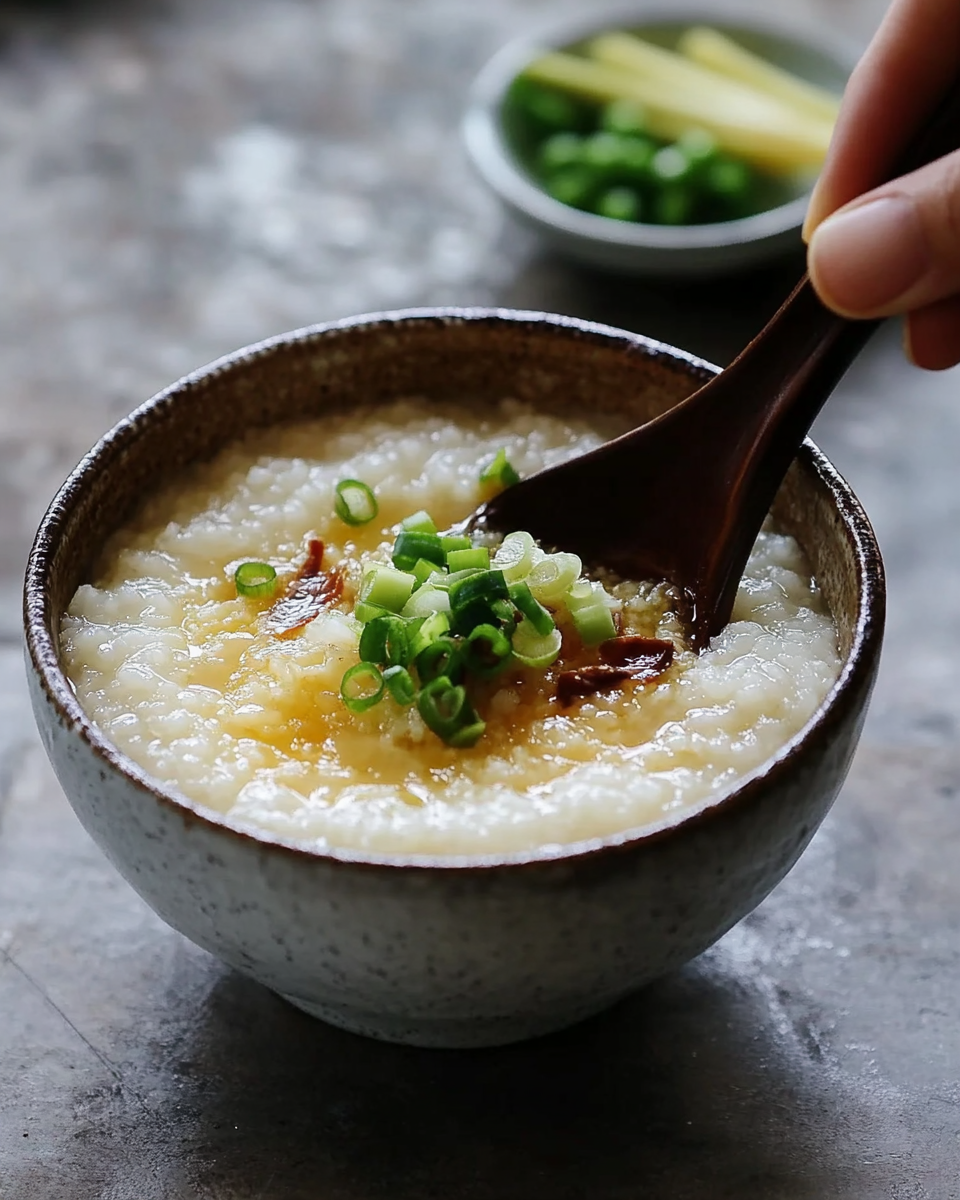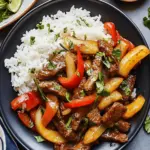A Versatile Dish: Sweet or Savory
One of the best features of congee is its versatility. Traditionally, congee is served as a savory dish, but it can easily be transformed into a sweet breakfast treat depending on the toppings you choose. The rice porridge itself is mild and neutral, offering a perfect canvas for a variety of toppings that can elevate the dish to your liking.
For a savory version, congee can be topped with pickled vegetables, shredded meats like chicken or pork, a soft-boiled egg, or even fried shallots. The addition of soy sauce and sesame oil enhances the savory depth of the dish, providing a comforting, umami-rich flavor. On the other hand, a sweet version of congee can be topped with fruits like bananas, berries, or mangoes, along with a drizzle of honey or a sprinkle of cinnamon, creating a naturally sweet and satisfying dish.
The flexibility of congee makes it ideal for any meal of the day. It’s a staple breakfast food in many Asian countries, but it also works wonderfully as a light lunch or a cozy dinner when you’re craving something simple yet comforting.
The Comforting Texture of Congee
What sets congee apart from other rice-based dishes is its smooth, creamy texture. When cooked, the rice grains break down and absorb the liquid, creating a porridge-like consistency that is rich yet light. This texture is perfect for soothing the body and comforting the mind, especially on a cold morning or after a long day. The rice becomes soft and tender, and the porridge itself is soothing to the stomach, making it a great option for those recovering from illness or simply looking for something easy to digest.
The consistency of the congee can be adjusted based on your personal preference. For a thicker, creamier porridge, cook the rice longer until it breaks down more. If you prefer a thinner consistency, simply add more liquid as the rice cooks and stir occasionally to ensure it doesn’t become too thick.
Cooking Congee: A Simple, Nourishing Process
Making congee is a straightforward process that doesn’t require much hands-on time. The basic recipe involves simmering rice in water or broth until the grains break down into a creamy porridge. It is important to rinse the rice first to remove excess starch, which ensures that the porridge doesn’t become overly sticky. Once the rice is rinsed, it is combined with the cooking liquid and brought to a boil. Afterward, the heat is reduced, and the mixture is simmered for about 30 to 40 minutes.
As the rice cooks, it will begin to absorb the liquid, expanding and softening. The longer the congee simmers, the creamier and smoother it becomes. You can continue to add water or broth as needed to achieve your desired consistency. If you prefer a thicker congee, cook it for a bit longer, but if you like it more soupy, add more liquid and cook for less time.
One of the great things about congee is that it is an ideal dish to make in advance. You can prepare a large batch and store it in the fridge, reheating it as needed throughout the week. This makes it perfect for meal prepping or preparing a comforting meal without much fuss.
Seasoning Congee for Flavor
While the rice porridge itself is mild, the addition of seasonings can bring the dish to life. For savory congee, a splash of soy sauce and sesame oil can add a rich umami flavor that pairs wonderfully with the soft rice. You can also incorporate other seasonings like ginger, garlic, or a dash of pepper to enhance the taste. If you prefer a sweeter version, a drizzle of honey or maple syrup and a sprinkle of cinnamon or nutmeg can create a deliciously comforting dish that’s perfect for breakfast.
Another key element of congee is the toppings. Toppings can be both savory and sweet, and they are what really bring the dish to life. For a savory version, you might top the porridge with a soft-boiled egg, some sautéed greens, or pickled vegetables, adding both texture and depth to the dish. For a sweet congee, fresh fruits like berries, sliced bananas, or mangoes pair beautifully with the creamy rice, making for a refreshing and satisfying breakfast or dessert.
The Perfect Toppings: Adding Variety and Texture
Congee is a blank canvas that can be topped with an endless array of ingredients to suit your taste preferences. For a savory bowl of congee, some popular toppings include sliced green onions, shredded chicken or pork, sautéed mushrooms, or even fried tofu for a plant-based option. Pickled vegetables, such as pickled ginger or radishes, can also add a delightful tang and crunch, balancing the rich creaminess of the porridge.
If you’re looking to make congee a heartier meal, you can add cooked grains like quinoa or farro, or even stir in some leftover vegetables for added nutrition. For a comforting, breakfast-style dish, top your congee with a soft-boiled egg, a sprinkle of sesame seeds, or a drizzle of chili oil for an extra kick.
On the sweeter side, congee can be topped with seasonal fruits, dried fruits, or a handful of granola. Coconut milk, almond butter, or peanut butter can also be added to make the dish more filling and provide a creamy texture. For those with a sweet tooth, a little brown sugar or maple syrup can turn congee into a comforting dessert or snack.
Health Benefits of Congee
Beyond being a comforting and delicious dish, congee is also packed with health benefits. The rice used in congee provides a source of carbohydrates, which are important for energy. When made with broth, congee also offers additional nutrients from the broth, such as protein, vitamins, and minerals, depending on the type of broth you choose. For example, chicken or pork broth can provide additional protein, while vegetable broth offers a lower-calorie option with plenty of vitamins and minerals.
Because congee is easy on the stomach and made with simple ingredients, it is often recommended for those recovering from illness or looking for a light, easily digestible meal. The dish is also incredibly hydrating, as it’s made with a high ratio of liquid to rice, making it a great option for staying hydrated.
Conclusion: A Comforting Dish for All Occasions
In conclusion, congee is a comforting and versatile rice porridge that can be enjoyed as a sweet or savory dish, depending on your mood or dietary preferences. Whether you enjoy it with a variety of savory toppings like pickled vegetables and meats or prefer a sweet version with fruits and spices, congee is a dish that can easily be customized to your liking. Its soothing, creamy texture and simple ingredients make it the perfect option for a light meal, breakfast, or even a snack. Not only is congee delicious, but it is also a nourishing dish that provides a variety of health benefits, making it a go-to comfort food for any occasion.






